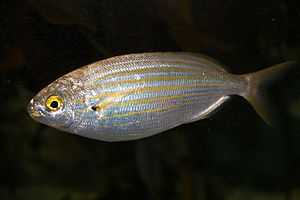Salema porgy
| Salema porgy | |
|---|---|
 | |
| Conservation status | |
| Scientific classification | |
| Kingdom: | Animalia |
| Phylum: | Chordata |
| Class: | Actinopterygii |
| Order: | Perciformes |
| Family: | Sparidae |
| Genus: | Sarpa Bonaparte, 1831 |
| Species: | S. salpa |
| Binomial name | |
| Sarpa salpa (Linnaeus, 1758) | |
Sarpa salpa, known commonly as the salema, salema porgy, cow bream or goldline, is a species of sea bream, recognisable by the golden stripes that run down the length of its body, and which can cause hallucinations when eaten.[2] It is found in the East Atlantic, as well as the Mediterranean, where ranging from the Bay of Biscay to South Africa.[3] It has occasionally been found as far north as Great Britain.[2] It is generally common and found from near the surface to a depth of 70 m (230 ft).[1] Males are typically 15 to 30 cm (6–12 in) in length, while females are usually 31 to 45 cm (12–18 in).[4] The maximum size is 51 cm (20 in).[3]
Sarpa salpa was reportedly consumed as a recreational drug during the time of the Roman Empire.[5] The fish became widely known for its psychoactivity following widely publicized articles in 2006, when two men ingested it at a Mediterranean restaurant and began to experience many auditory and visual hallucinogenic effects.[5] These hallucinations, described as frightening, were reported to have occurred minutes after the fish was ingested and had a total duration of 36 hours.
Ichthyoallyeinotoxism, or hallucinogenic fish poisoning, is common in other species of fish but not in Sarpa salpa, which is not normally psychoactive. It is, in fact, often served as a dish at seafood restaurants in the Mediterranean area. It is believed that the fish ingests a particular algae or phytoplankton which renders it hallucinogenic. The effects described are similar to those of indole tryptamine psychedelics.[5]
References
- ↑ 1.0 1.1 Bizsel, C., Kara, M.H., Pollard, D., Yokes, B., Goren, M. & Francour, P. (2011). "Sarpa salpa". IUCN Red List of Threatened Species. Version 2014.3. International Union for Conservation of Nature.
- ↑ 2.0 2.1 Fish that triggers hallucinations found off British coast. The Daily Telegraph May 13, 2009. Accessed May 27, 2013.
- ↑ 3.0 3.1 Froese, Rainer and Pauly, Daniel, eds. (2015). "Sarpa salpa" in FishBase. April 2015 version.
- ↑ "Activity patterns, home-range size, and habitat utilization of Sarpa salpa (Teleostei: Sparidae) in the Mediterranean Sea". ICES Journal of Marine Science 63 (1): 128–139. 2006. doi:10.1016/j.icesjms.2005.06.010. Retrieved 12 February 2015.
- ↑ 5.0 5.1 5.2 Pommier, De Haro (October 2006). "Hallucinatory Fish Poisoning (Ichthyoallyeinotoxism): Two Case Reports From the Western Mediterranean and Literature Review". Clinical Toxicology 2006, Vol. 44, No. 2 : Pages 187. Retrieved 2010-07-19.
| Wikimedia Commons has media related to Sarpa salpa. |
